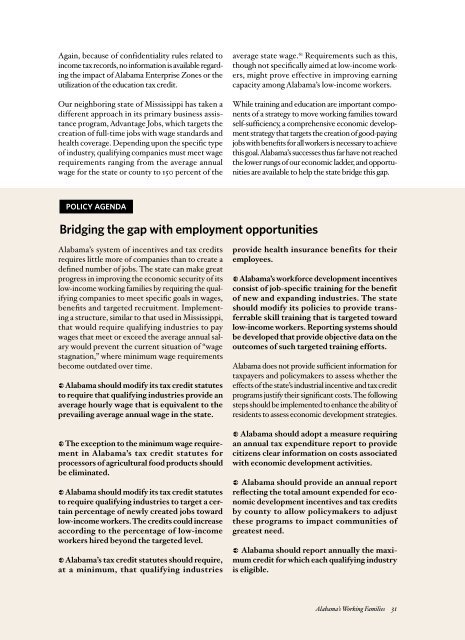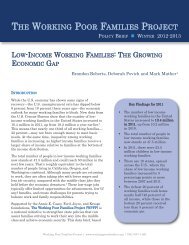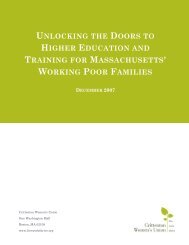alabama's working families and the broken promise of economic ...
alabama's working families and the broken promise of economic ...
alabama's working families and the broken promise of economic ...
- No tags were found...
You also want an ePaper? Increase the reach of your titles
YUMPU automatically turns print PDFs into web optimized ePapers that Google loves.
Again, because <strong>of</strong> confidentiality rules related toincome tax records, no information is available regarding<strong>the</strong> impact <strong>of</strong> Alabama Enterprise Zones or <strong>the</strong>utilization <strong>of</strong> <strong>the</strong> education tax credit.Our neighboring state <strong>of</strong> Mississippi has taken adifferent approach in its primary business assistanceprogram, Advantage Jobs, which targets <strong>the</strong>creation <strong>of</strong> full-time jobs with wage st<strong>and</strong>ards <strong>and</strong>health coverage. Depending upon <strong>the</strong> specific type<strong>of</strong> industry, qualifying companies must meet wagerequirements ranging from <strong>the</strong> average annualwage for <strong>the</strong> state or county to 150 percent <strong>of</strong> <strong>the</strong>average state wage. 61 Requirements such as this,though not specifically aimed at low-income workers,might prove effective in improving earningcapacity among Alabama’s low-income workers.While training <strong>and</strong> education are important components<strong>of</strong> a strategy to move <strong>working</strong> <strong>families</strong> towardself-sufficiency, a comprehensive <strong>economic</strong> developmentstrategy that targets <strong>the</strong> creation <strong>of</strong> good-payingjobs with benefits for all workers is necessary to achievethis goal. Alabama’s successes thus far have not reached<strong>the</strong> lower rungs <strong>of</strong> our <strong>economic</strong> ladder, <strong>and</strong> opportunitiesare available to help <strong>the</strong> state bridge this gap.POLICY AGENDABridging <strong>the</strong> gap with employment opportunitiesAlabama’s system <strong>of</strong> incentives <strong>and</strong> tax creditsrequires little more <strong>of</strong> companies than to create adefined number <strong>of</strong> jobs. The state can make greatprogress in improving <strong>the</strong> <strong>economic</strong> security <strong>of</strong> itslow-income <strong>working</strong> <strong>families</strong> by requiring <strong>the</strong> qualifyingcompanies to meet specific goals in wages,benefits <strong>and</strong> targeted recruitment. Implementinga structure, similar to that used in Mississippi,that would require qualifying industries to paywages that meet or exceed <strong>the</strong> average annual salarywould prevent <strong>the</strong> current situation <strong>of</strong> “wagestagnation,” where minimum wage requirementsbecome outdated over time.[ Alabama should modify its tax credit statutesto require that qualifying industries provide anaverage hourly wage that is equivalent to <strong>the</strong>prevailing average annual wage in <strong>the</strong> state.[ The exception to <strong>the</strong> minimum wage requirementin Alabama’s tax credit statutes forprocessors <strong>of</strong> agricultural food products shouldbe eliminated.[ Alabama should modify its tax credit statutesto require qualifying industries to target a certainpercentage <strong>of</strong> newly created jobs towardlow-income workers. The credits could increaseaccording to <strong>the</strong> percentage <strong>of</strong> low-incomeworkers hired beyond <strong>the</strong> targeted level.[ Alabama’s tax credit statutes should require,at a minimum, that qualifying industriesprovide health insurance benefits for <strong>the</strong>iremployees.[ Alabama’s workforce development incentivesconsist <strong>of</strong> job-specific training for <strong>the</strong> benefit<strong>of</strong> new <strong>and</strong> exp<strong>and</strong>ing industries. The stateshould modify its policies to provide transferrableskill training that is targeted towardlow-income workers. Reporting systems shouldbe developed that provide objective data on <strong>the</strong>outcomes <strong>of</strong> such targeted training efforts.Alabama does not provide sufficient information fortaxpayers <strong>and</strong> policymakers to assess whe<strong>the</strong>r <strong>the</strong>effects <strong>of</strong> <strong>the</strong> state’s industrial incentive <strong>and</strong> tax creditprograms justify <strong>the</strong>ir significant costs. The followingsteps should be implemented to enhance <strong>the</strong> ability <strong>of</strong>residents to assess <strong>economic</strong> development strategies.[ Alabama should adopt a measure requiringan annual tax expenditure report to providecitizens clear information on costs associatedwith <strong>economic</strong> development activities.[ Alabama should provide an annual reportreflecting <strong>the</strong> total amount expended for <strong>economic</strong>development incentives <strong>and</strong> tax creditsby county to allow policymakers to adjust<strong>the</strong>se programs to impact communities <strong>of</strong>greatest need.[ Alabama should report annually <strong>the</strong> maximumcredit for which each qualifying industryis eligible.Alabama’s Working Families 31







